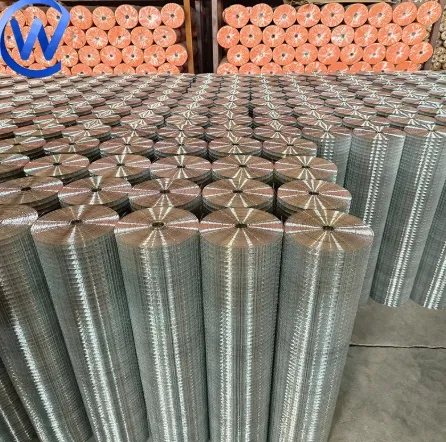-
+86 15030157877
-
sales@galvanizedmetalmesh.com
ก.ค. . 15, 2025 14:00 กลับไปที่รายการ
Durable Barrier Solutions: Welded Wire Mesh and Fencing Systems Unveiled
In the realm of security, agriculture, and industrial applications, wire mesh fencing systems have established themselves as reliable and versatile solutions. Among these, รั้วตาข่ายลวดเชื่อม, chicken cage wire mesh, ลวดตาข่ายรั้วการเชื่อมโยงโซ่ชุบสังกะสี, framed wire mesh fence, and iron wire mesh fence stand out for their durability, functionality, and adaptability across diverse environments. Each type offers unique advantages, tailored to specific needs in residential, commercial, and agricultural settings.

Unveiling the Strength of Weld Wire Mesh Fence
Constructed through precise welding of metal wires at each intersection, รั้วตาข่ายลวดเชื่อม offers superior structural integrity. This fencing type is widely used in industrial sites, construction perimeters, and residential gardens where robust security is paramount. The welded joints ensure the mesh maintains its shape even under tension, resisting deformation from impacts or attempts at forced entry. For example, in commercial warehouses, รั้วตาข่ายลวดเชื่อม can enclose storage areas, protecting inventory while allowing visibility for monitoring. Its versatility extends to agricultural use, where it may serve as a barrier for livestock or a support structure for climbing plants in vineyards or orchards. The mesh size and wire gauge can be customized to balance security with ventilation or light penetration.
The Practicality of Chicken Cage Wire Mesh
Chicken cage wire mesh is a specialized fencing solution designed primarily for poultry and small livestock containment. Composed of galvanized or PVC - coated wires, this mesh offers rust resistance and durability in outdoor environments. The evenly spaced openings are sized to prevent chicks or adult birds from escaping while keeping out predators like rodents or foxes. In backyard farms or commercial poultry operations, chicken cage wire mesh is used to build coops, runs, and enclosures, providing a safe and secure habitat for birds. Its lightweight nature also makes it easy to install and modify, allowing farmers to adapt enclosures as their flocks grow. Beyond poultry, this mesh can be repurposed for gardening tasks, such as creating trellises for climbing vegetables or protective barriers around flower beds.
Galvanized Chain Link Fence Wire Mesh: A Blend of Durability and Affordability
Galvanized chain link fence wire mesh combines the classic chain link design with a protective zinc coating, enhancing resistance to corrosion and weathering. This makes it ideal for outdoor applications in harsh environments, such as coastal areas or regions with high humidity. The galvanized finish ensures the wire mesh maintains its structural integrity over time, reducing the need for frequent maintenance. In sports complexes, ลวดตาข่ายรั้วการเชื่อมโยงโซ่ชุบสังกะสี is commonly used to enclose basketball courts or baseball fields, offering a cost - effective barrier that withstands constant exposure to the elements. For residential use, it provides a practical solution for securing large yards or separating property boundaries, with options for varying heights and mesh densities to suit different needs.
Framed Wire Mesh Fence: Structure and Style Combined
Framed wire mesh fence elevates the traditional wire mesh by incorporating a sturdy frame, typically made of steel or aluminum, around the perimeter of the mesh. This design enhances the fence’s stability and resistance to bending, making it suitable for high - wind areas or locations with heavy foot traffic. The frame also allows for easier installation, as it provides a rigid structure to attach to posts or walls. In commercial settings, such as parking garages or industrial facilities, framed wire mesh fence offers a sleek, modern appearance while delivering robust security. Residential applications may include decorative fencing for gardens or balconies, where the frame can be powder - coated in various colors to complement architectural styles, blending functionality with aesthetic appeal.
Iron Wire Mesh Fence: Timeless Elegance and Robustness
Iron wire mesh fence combines the strength of iron with the versatility of wire mesh, creating a fencing solution that balances durability with decorative appeal. Wrought iron or cast iron elements can be integrated into the mesh design, adding intricate patterns or ornate details that enhance curb appeal in residential or commercial properties. Despite its aesthetic focus, iron wire mesh fence does not compromise on security; the thick iron wires and solid construction deter unauthorized access. In historic districts or upscale neighborhoods, this fencing type is often used to enclose estates or public parks, providing a timeless look that withstands the test of time. Proper maintenance, such as periodic painting or rust prevention treatments, ensures the iron mesh remains in prime condition for decades.
FAQ: Key Insights for Wire Mesh Fencing
How to Select the Right Wire Mesh Fence for Agricultural Use?
For agricultural applications, prioritize chicken cage wire mesh or รั้วตาข่ายลวดเชื่อม based on the livestock size and security needs. Smaller mesh sizes (e.g., 1x1 inch) are ideal for chicks or rabbits, while larger meshes may suit goats or cattle. Galvanized coatings are essential for outdoor use to resist rust from moisture or manure. Consider the fence height and sturdiness to prevent animals from jumping or breaking through, and ensure proper grounding to withstand wind or weather events.
What Maintenance Steps Ensure Longevity of Galvanized Chain Link Fence Wire Mesh?
Regularly inspect ลวดตาข่ายรั้วการเชื่อมโยงโซ่ชุบสังกะสี for signs of coating damage, such as chips or exposed metal, which can lead to rust. Clean the mesh periodically with a soft brush and mild detergent to remove dirt or debris that traps moisture. In coastal areas, rinse the fence with fresh water to prevent salt buildup. For minor rust spots, sand the affected area and apply a touch - up paint compatible with galvanized surfaces to extend the fence’s lifespan.
Can Framed Wire Mesh Fence Be Customized for Unique Property Shapes?
Yes, framed wire mesh fence is highly customizable. The frame can be cut, bent, or welded to fit irregular property lines, curved paths, or angled structures. Manufacturers often offer bespoke solutions, allowing the mesh size, frame material, and finish to be tailored to specific design requirements. This flexibility makes it suitable for properties with complex layouts or those requiring a combination of security and aesthetic integration.
What Are the Advantages of Iron Wire Mesh Fence Over Other Materials?
Iron wire mesh fence offers superior strength and a classic aesthetic that other materials like aluminum or PVC cannot fully replicate. Iron’s weight and durability make it resistant to impact and vandalism, while its malleability allows for intricate designs. Though it may require more maintenance than galvanized steel (due to its susceptibility to rust if not properly treated), iron fencing adds a timeless, luxurious appeal that enhances property value, particularly in upscale or historic settings.
How to Ensure Proper Installation of Weld Wire Mesh Fence?
Start by measuring the area and selecting the appropriate รั้วตาข่ายลวดเชื่อม (specifications), including mesh size and wire gauge. Install sturdy posts at regular intervals (typically 8–10 feet apart) and secure them with concrete for stability. Unroll the mesh and attach it to the posts using wire ties or clamps, ensuring it is taut to prevent sagging. For added security, bury the bottom edge of the mesh 6–12 inches underground to deter digging pests or intruders. Always follow local building codes and manufacturer guidelines for optimal results.
-
Stainless Steel Wire Mesh | 304/316, Factory Direct Prices
ข่าวNov.17,2025
-
Stainless Steel Wire Mesh – Durable, Rust-Resistant, Exact
ข่าวNov.17,2025
-
Expanded Metal Mesh: Custom, Durable, Factory-Direct Supply
ข่าวNov.17,2025
-
Security Window Screen Mesh | Stainless Steel, Anti-Theft
ข่าวNov.17,2025
-
Anti Bird Spikes Exporter – Durable Humane OEM Wholesale
ข่าวNov.17,2025
-
Metal Mesh Fabric For Glass Laminated - UV-Stable, Custom
ข่าวNov.11,2025



